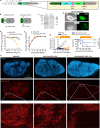Chemogenetic ON and OFF switches for RNA virus replication
- PMID: 33649317
- PMCID: PMC7921684
- DOI: 10.1038/s41467-021-21630-5
Chemogenetic ON and OFF switches for RNA virus replication
Abstract
Therapeutic application of RNA viruses as oncolytic agents or gene vectors requires a tight control of virus activity if toxicity is a concern. Here we present a regulator switch for RNA viruses using a conditional protease approach, in which the function of at least one viral protein essential for transcription and replication is linked to autocatalytical, exogenous human immunodeficiency virus (HIV) protease activity. Virus activity can be en- or disabled by various HIV protease inhibitors. Incorporating the HIV protease dimer in the genome of vesicular stomatitis virus (VSV) into the open reading frame of either the P- or L-protein resulted in an ON switch. Here, virus activity depends on co-application of protease inhibitor in a dose-dependent manner. Conversely, an N-terminal VSV polymerase tag with the HIV protease dimer constitutes an OFF switch, as application of protease inhibitor stops virus activity. This technology may also be applicable to other potentially therapeutic RNA viruses.
Conflict of interest statement
A patent application relating to all aspects of the manuscript has been filed under the application number 19181717 by Boehringer Ingelheim International GmbH (application date 21 June 2019). E.H., J.K., B.H., L.E., T.N., G.W., and D.v.L. are listed as inventors. T.N., C.U., and L.E. are employed by ViratTherapeutics GmbH. D.v.L. is founder of ViraTherapeutics GmbH. D.v.L. and G.W. serve as scientific advisors to Boehringer Ingelheim Pharma K.G. ViraTherapeutics or Boehringer Ingelheim had no role in the study design, data analysis and interpretation, or the writing of the manuscript. The other authors declare no competing interests.
Figures



References
Publication types
MeSH terms
Substances
LinkOut - more resources
Full Text Sources
Other Literature Sources
Research Materials
Miscellaneous

